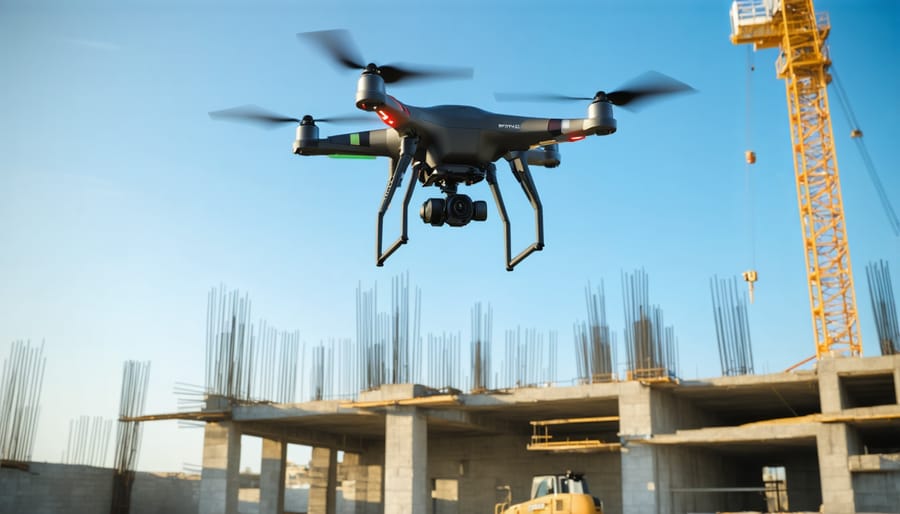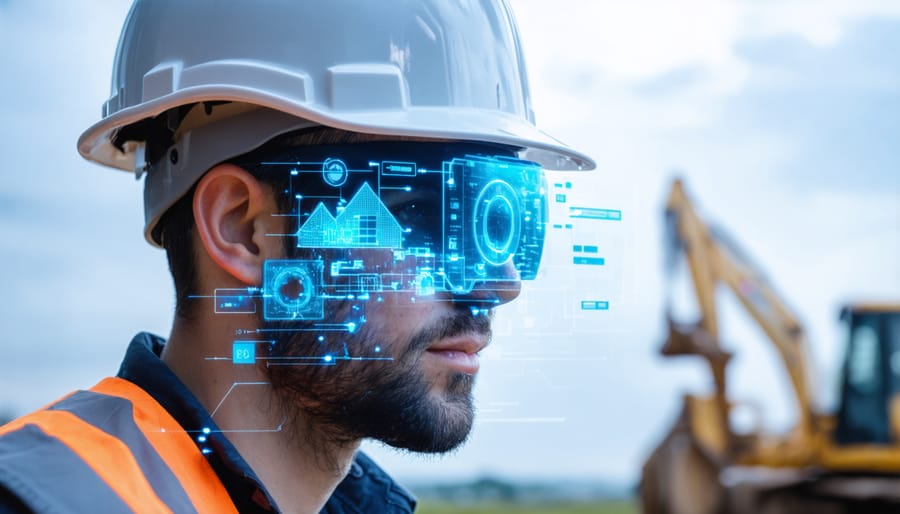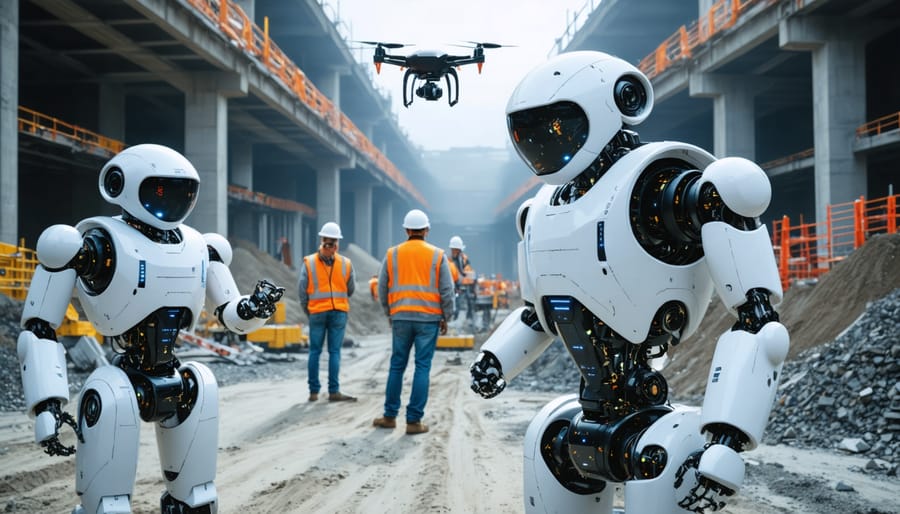The construction industry is on the brink of a technological revolution, with smart tools poised to transform every aspect of building projects. From robotic bricklayers and self-driving excavators to AI-powered design software and IoT sensors, these cutting-edge innovations are reshaping how we plan, execute, and manage construction. As productivity soars, costs plummet, and safety reaches new heights, forward-thinking professionals must embrace this smart tool revolution or risk being left behind. In this article, we’ll explore the most game-changing technologies, their real-world applications, and the immense potential they hold for construction’s future. Get ready to discover how smart tools are not just changing the way we build – they’re redefining what’s possible.
Drones and Aerial Imaging

Benefits and Applications
The use of drones in construction projects offers numerous advantages that can significantly improve efficiency, safety, and cost-effectiveness. By providing aerial surveys and real-time monitoring, drones enable project managers to gather accurate data quickly, reducing the need for manual inspections and minimizing potential errors. This enhanced data collection allows for more informed decision-making and better project planning. Additionally, drones can access hard-to-reach or hazardous areas, improving job site safety and reducing the risk of accidents. Drones equipped with thermal imaging cameras can detect heat leaks, electrical issues, and structural defects, facilitating proactive maintenance and preventing costly repairs. Furthermore, the integration of drone data with BIM (Building Information Modeling) systems enables the creation of detailed 3D models, enhancing collaboration among project stakeholders and streamlining workflows. By leveraging the capabilities of drones, construction companies can optimize resource allocation, improve quality control, and ultimately deliver projects more efficiently and cost-effectively.
Case Studies
Numerous construction companies have successfully integrated drones into their operations, realizing significant benefits. For instance, Brasfield & Gorrie, a leading U.S. contractor, has been using drones since 2015 for site surveying, progress monitoring, and safety inspections. By leveraging drones, they have reduced survey time by up to 90% and improved overall project efficiency.
Similarly, Skanska, a global construction firm, has employed drones for tasks such as site mapping, earthwork calculations, and real-time progress tracking. Their drone program has resulted in more accurate data collection, enhanced collaboration among teams, and faster decision-making processes.
These case studies demonstrate the tangible advantages of drone technology in the construction industry, from streamlining workflows and improving safety to enabling better communication and data-driven insights. As more companies adopt drones, the industry is poised to see widespread transformation and increased productivity.

Wearable Technology
Connectivity and Data Collection
In the era of smart construction, wearables have emerged as a key technology that seamlessly integrates with IoT systems to revolutionize data collection and connectivity on job sites. These innovative devices, worn by workers, can monitor vital signs, track location, and detect potential hazards, providing real-time insights that enhance worker safety and productivity. By collecting and transmitting data to centralized platforms, wearables enable project managers to make data-driven decisions, optimize resource allocation, and proactively address issues. The integration of wearables with IoT networks also facilitates seamless communication and collaboration among team members, ensuring everyone stays connected and informed. As the construction industry continues to embrace digital transformation, the synergy between wearables and IoT systems will play an increasingly crucial role in shaping the future of smart construction, driving efficiency, safety, and innovation on job sites worldwide.
Emerging Trends
Emerging trends in construction wearables are set to revolutionize worker safety and efficiency on job sites. Cutting-edge smart helmets equipped with augmented reality displays can provide real-time information and guidance, enabling workers to navigate complex projects with ease. Advanced exoskeletons are being developed to reduce physical strain and prevent injuries during demanding tasks like heavy lifting. Additionally, smart vests with built-in sensors can monitor vital signs, detect falls, and alert supervisors to potential health risks. As these technologies continue to evolve, they hold immense potential for enhancing worker well-being and productivity. However, widespread adoption will require addressing challenges such as cost, data privacy concerns, and seamless integration with existing workflows. As the industry moves forward, collaborations between technology providers and construction firms will be crucial in shaping the future of smart wearables on the job site.
Augmented and Virtual Reality
Improving Collaboration
Augmented Reality (AR) and Virtual Reality (VR) technologies are revolutionizing collaboration in the construction industry. By creating immersive, shared virtual environments, AR/VR enables teams to communicate and collaborate more effectively, regardless of their physical location. With AR, team members can overlay digital information onto the real world, allowing them to visualize and discuss design changes, identify potential issues, and make informed decisions in real-time. VR, on the other hand, enables users to fully immerse themselves in a virtual representation of the project, facilitating remote collaboration and reducing the need for costly site visits. These technologies enhance communication between architects, engineers, contractors, and clients, enabling them to explore and refine designs together, catch errors early, and streamline decision-making processes. By breaking down geographical barriers and providing a common visual language, AR/VR is driving a new era of efficient, seamless collaboration in the construction industry.

Enhancing Safety
Augmented Reality (AR) and Virtual Reality (VR) technologies are transforming safety practices in the construction industry. By leveraging immersive simulations, construction professionals can now identify and mitigate potential hazards before they occur on real job sites. These powerful tools allow teams to virtually walk through a project, pinpointing areas of concern and testing various safety measures in a risk-free environment. AR overlays can highlight dangers such as fall risks, electrical hazards, or heavy machinery paths, ensuring workers remain alert and prepared. Moreover, VR training modules enable workers to practice safe procedures and emergency responses, enhancing their skills and readiness. By proactively addressing safety issues in the virtual realm, smart construction tools contribute to creating safer, more efficient work environments while promoting sustainability through reduced accidents and improved project outcomes. As these technologies continue to advance, they hold immense potential to revolutionize safety management in the construction sector.
Construction Robotics
Productivity Gains
Robotic automation in construction is revolutionizing project productivity and efficiency. By deploying robots for repetitive, labor-intensive tasks like bricklaying, welding, and concrete mixing, contractors can significantly accelerate project timelines. These tireless machines work around the clock with unparalleled precision, reducing human error and rework. Moreover, robots can operate in hazardous or hard-to-reach areas, minimizing safety risks for workers.
The productivity gains extend beyond the construction site. Prefabrication with robotic assistance allows for faster, more accurate assembly of building components off-site, streamlining on-site installation. Advanced robotic systems can also optimize material handling and inventory management, reducing waste and costs.
While the upfront investment in robotic technology may be substantial, the long-term labor cost savings and productivity improvements offer a compelling return on investment for forward-thinking construction firms. As the technology continues to advance, expect robots to become increasingly integral to achieving ambitious project goals on time and within budget.
Overcoming Challenges
While smart construction tools offer numerous benefits, it’s crucial to address concerns around job displacement and integration with human workers. Expert interviews reveal that these technologies are designed to augment, rather than replace, skilled labor. By automating repetitive tasks and providing real-time data, smart tools enable workers to focus on higher-value activities that require human expertise and decision-making. Successful adoption involves training programs to upskill workers and fostering a culture of collaboration between humans and technology. Case studies demonstrate that when implemented strategically, smart tools can enhance productivity, safety, and job satisfaction while creating new roles in data analysis, robotics maintenance, and digital project management. As the industry evolves, ongoing dialogue between stakeholders is essential to ensure that the integration of smart tools benefits both businesses and their workforce.
3D Printing
Materials and Techniques
Advances in 3D printing technology have revolutionized the construction industry, enabling the creation of complex structures and components with unprecedented precision and efficiency. Cutting-edge 3D printers can now utilize a wide range of printable building materials, such as concrete, clay, and even recycled plastic, to produce structurally sound and aesthetically pleasing elements. These materials are carefully engineered to exhibit desirable properties like high strength, durability, and resistance to environmental factors. By leveraging the power of 3D printing, construction professionals can streamline the fabrication process, reduce material waste, and explore innovative design possibilities that were previously unattainable with traditional construction methods. As the technology continues to evolve, it is expected to play an increasingly vital role in shaping the future of smart construction.
Sustainability Benefits
3D printing technology offers significant sustainability benefits in the construction industry. By enabling precise material placement and minimizing waste, 3D printing reduces the environmental impact of building projects. Unlike traditional construction methods that often result in excess materials being discarded, 3D printing allows for the creation of complex structures using only the necessary amount of resources. This not only conserves raw materials but also decreases the energy consumption and emissions associated with material production and transportation. Furthermore, 3D printing facilitates the use of eco-friendly, recycled, and locally sourced materials, further enhancing the sustainability of construction projects. As the technology advances, it opens up possibilities for incorporating innovative, green materials that contribute to healthier, more energy-efficient buildings. By embracing 3D printing, the construction industry can significantly reduce its carbon footprint and pave the way for a more sustainable future.
Conclusion
The future of construction is undeniably intertwined with the adoption of smart tools and technologies. As the industry continues to evolve, the integration of AI, IoT, robotics, and other cutting-edge innovations will become increasingly crucial for companies looking to remain competitive and efficient. The transformative potential of these smart construction tools is immense, promising to revolutionize the way projects are planned, executed, and managed.
In the coming years, we can expect to see even more advanced applications of AI in construction, from intelligent design optimization to predictive maintenance and beyond. The IoT will continue to expand, connecting more devices and equipment on job sites, enabling real-time monitoring, and facilitating seamless communication between stakeholders. Robotics and automation will likely play a more significant role in construction, taking on tasks that are dangerous, repetitive, or physically demanding for human workers.
The adoption of smart construction tools will not only drive productivity and cost savings but also contribute to safer, more sustainable, and higher-quality projects. As technology continues to advance, the construction industry must embrace these innovations to unlock new opportunities and overcome long-standing challenges.
However, the successful integration of smart tools will require a concerted effort from all stakeholders, including construction companies, technology providers, policymakers, and educators. Investing in workforce training, establishing industry standards, and fostering a culture of innovation will be essential to fully harness the potential of these technologies.
The future of construction is bright, and smart tools will undoubtedly play a pivotal role in shaping it. By staying informed, adaptable, and proactive, construction professionals can position themselves at the forefront of this technological revolution and reap the benefits of a smarter, more connected industry.

